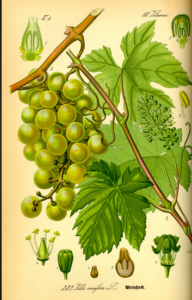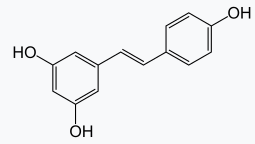Plants and the chemicals they make: Vitis vinifera (grape) and resveratrol

The plant: Vitis vinifera
Suggestions: You can listen to Libiamo ne’ lieti calici (La traviata) while reading this post.
I say grape and you think wine. But you should also remember grape seed oil. And grape seed pronathocyanidins. And resveratrol!
Besides the chemicals involved in basic everyday life, like chlorophyll, Rubisco, cellulose, etc., Vitis is full of “secondary metabolites”.
The chemicals
Vitis vinifera red cultivars are rich in anthocyanins that impart their color to the berries (generally in the skin). Anthocyanins can be found in the skin of the berries, hydroxycinnamic acids in the pulp and condensed tannins of the proanthocyanidins type in the seeds. Stilbenoids can be found in the skin and in wood. Trans-resveratrol is a phytoalexin produced against the growth of fungal pathogens such as Botrytis cinerea and delta-viniferin is another grapevine phytoalexin produced following fungal infection by Plasmopara viticola.
The aroma: isoprenoid monoterpenes are present in grape, above all acyclic linalool, geraniol, nerol, citronellol, homotrienol and monocyclic α-terpineol, mostly occurring as glycosides. Carotenoids accumulate in ripening grape berries. Oxidation of carotenoids produces volatile fragments, C13-norisoprenoids. These are strongly odoriferous compounds, such as β-ionone (aroma of viola), damascenone (aroma of exotic fruits), β-damascone (aroma of rose) and β-ionol (aroma of flowers and fruits).
Grape seeds are rich in unsaturated fatty acids, which help to lower total cholesterol and LDL cholesterol in the blood. Great oil for cooking!
Resveratrol

Figure. Resveratrol.
What’s so special about resveratrol? Made famous by “the French paradox”, I dedicated several posts to this chemical (and to sirtuins) that the grape plant makes not for us (it keeps fungal pathogens at bay) but we should very thankful that it is there for our great benefit.
The French paradox: Despite the high consumption of saturated fats like butter, French people have a lower than expected incidence of heart disease, a fact attributed to their higher consumption of red wine. The hypothesis: resveratrol activates sirtuins. Sirtuins are proteins with a very important role in the human cell: they control the enzyme that converts acetate, a source of calories, into acetyl CoA, a key point of entry to cellular respiration. Because of this crucial role, it has been proposed that it may be possible to control age-related disorders in various organisms, and in humans. These disorders include obesity, metabolic syndrome, type II diabetes, Parkinson’s disease and the “ultimate disorder”: aging.
You will find resveratrol and other chemicals with similar activity in Skin Actives products, like UV repair cream, anti-aging cream, revitalizing nutrient cream, and more.
References
Imai S., Guarente L. (2014) NAD+ and Sirtuins in Aging and Disease. Trends Cell Biol. 2014 Aug; 24(8): 464–471. 10.1016/j.tcb.2014.04.002
Disclaimer: Claims on this page have not been evaluated by the FDA and are not intended to diagnose, cure, treat or prevent any disease.
